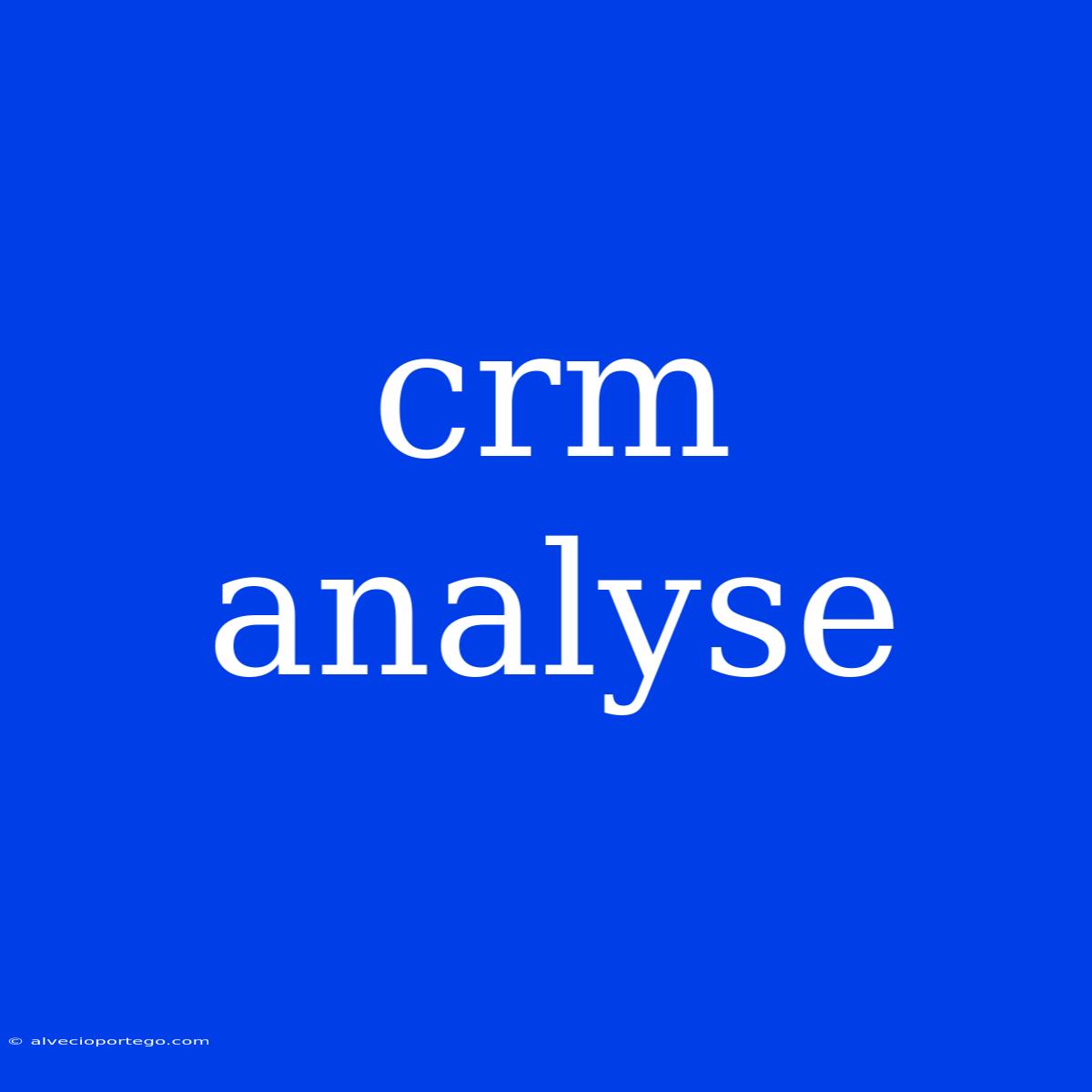Unveiling the Power of CRM Analysis: How to Turn Data into Actionable Insights
Is your CRM system just a repository of customer data, or a strategic tool for growth? CRM analysis transforms raw data into actionable insights, allowing you to understand customer behavior, optimize marketing efforts, and drive revenue. Editor Note: CRM analysis is a vital aspect of modern business, empowering companies to make data-driven decisions and unlock growth potential.
This article will delve into the crucial aspects of CRM analysis, uncovering its importance and demonstrating how to leverage it effectively. By exploring key elements like data integration, segmentation, and reporting, you'll gain a comprehensive understanding of how CRM analysis can help your organization reach its full potential.
Why is CRM analysis essential?
Imagine a world where you can predict customer needs, personalize marketing campaigns, and proactively address potential issues before they arise. This isn't science fiction; it's the reality of leveraging CRM analysis. By understanding customer behavior, you can:
- Increase customer satisfaction: Tailor interactions to individual preferences, improving their experience and loyalty.
- Maximize marketing ROI: Target the right audience with the right message, enhancing campaign effectiveness.
- Drive sales growth: Identify high-potential leads and personalize sales outreach, boosting conversion rates.
- Enhance customer retention: Recognize churn indicators and implement proactive strategies to keep customers engaged.
- Gain competitive advantage: Develop a deep understanding of your market and customer needs, setting your business apart.
Analyzing CRM data involves a systematic approach:
- Data Integration: Connect your CRM system with other relevant data sources like your website, marketing automation tools, and social media platforms. This creates a comprehensive view of customer interactions across all channels.
- Data Cleansing & Standardization: Ensure accuracy and consistency by cleaning and standardizing your data. Removing duplicates, resolving inconsistencies, and standardizing formats are critical steps for meaningful analysis.
- Segmentation: Divide your customer base into meaningful segments based on demographics, behavior, preferences, and other relevant factors. This allows you to tailor your strategies to specific groups, enhancing effectiveness.
- Reporting & Visualization: Transform raw data into insightful reports and visualizations. Dashboards, charts, and graphs make complex data easily digestible, enabling quick identification of trends, patterns, and opportunities.
- Analysis & Interpretation: Interpret the data to glean meaningful insights and identify actionable steps. Ask questions, identify correlations, and formulate strategies based on the insights revealed.
Key Takeaways of CRM Analysis
| Aspect | Description |
|---|---|
| Data-driven Decisions | Make informed choices based on customer insights, enhancing accuracy and effectiveness. |
| Customer-Centric Approach | Prioritize customer needs and preferences in all your endeavors, fostering loyalty and satisfaction. |
| Improved Efficiency | Streamline processes, eliminate manual tasks, and automate workflows for optimal resource utilization. |
| Enhanced Profitability | Drive revenue growth, increase marketing ROI, and improve customer retention, leading to improved financial performance. |
| Competitive Advantage | Gain a deeper understanding of your market and customer needs, setting your business apart from competitors. |
Navigating the CRM Analysis Landscape:
Data Integration:
- Connecting data sources: Integrate your CRM system with other relevant platforms, such as your website analytics, email marketing tools, and social media platforms.
- API utilization: Use APIs to seamlessly transfer data between different systems, ensuring consistency and real-time updates.
- Data warehousing: Utilize data warehouses to store and manage large volumes of data from various sources, creating a centralized repository for analysis.
Segmentation:
- Customer profiling: Create detailed customer profiles based on demographics, behavior, purchase history, and other relevant information.
- Behavior-based segmentation: Group customers based on their website activity, email engagement, and product interactions.
- Value-based segmentation: Classify customers based on their revenue potential, lifetime value, and overall profitability.
Reporting & Visualization:
- Dashboards: Create interactive dashboards with key performance indicators (KPIs) that provide a real-time overview of your customer data.
- Charts & graphs: Utilize various visualization techniques like bar charts, line graphs, pie charts, and heat maps to present data in a compelling and easy-to-understand format.
- Predictive analytics: Employ advanced analytics tools to identify trends, patterns, and potential future outcomes based on historical data.
Analyzing the Connection Between CRM Analysis and Business Growth:
Customer Acquisition:
- Targeted marketing: Leverage CRM data to identify potential customers and tailor marketing campaigns to their specific needs and interests.
- Lead scoring: Assign scores to leads based on their engagement and likelihood of conversion, prioritizing outreach efforts.
- Personalized communication: Use CRM data to send personalized emails, messages, and offers, increasing engagement and conversion rates.
Customer Retention:
- Customer segmentation: Identify at-risk customers and implement targeted retention strategies based on their specific needs and behaviors.
- Customer journey mapping: Understand the customer journey and identify touchpoints where engagement and loyalty can be strengthened.
- Proactive customer service: Utilize CRM data to predict customer needs and proactively address issues before they escalate.
Conclusion:
CRM analysis empowers businesses to leverage data to enhance customer experiences, optimize marketing strategies, and drive revenue growth. By embracing data-driven decision-making, companies can gain a deeper understanding of their customer base, tailor interactions to individual preferences, and ultimately achieve sustainable business success.
Let the power of data drive your business forward. Implement a robust CRM analysis strategy, and unlock the true potential of your customer relationships.

